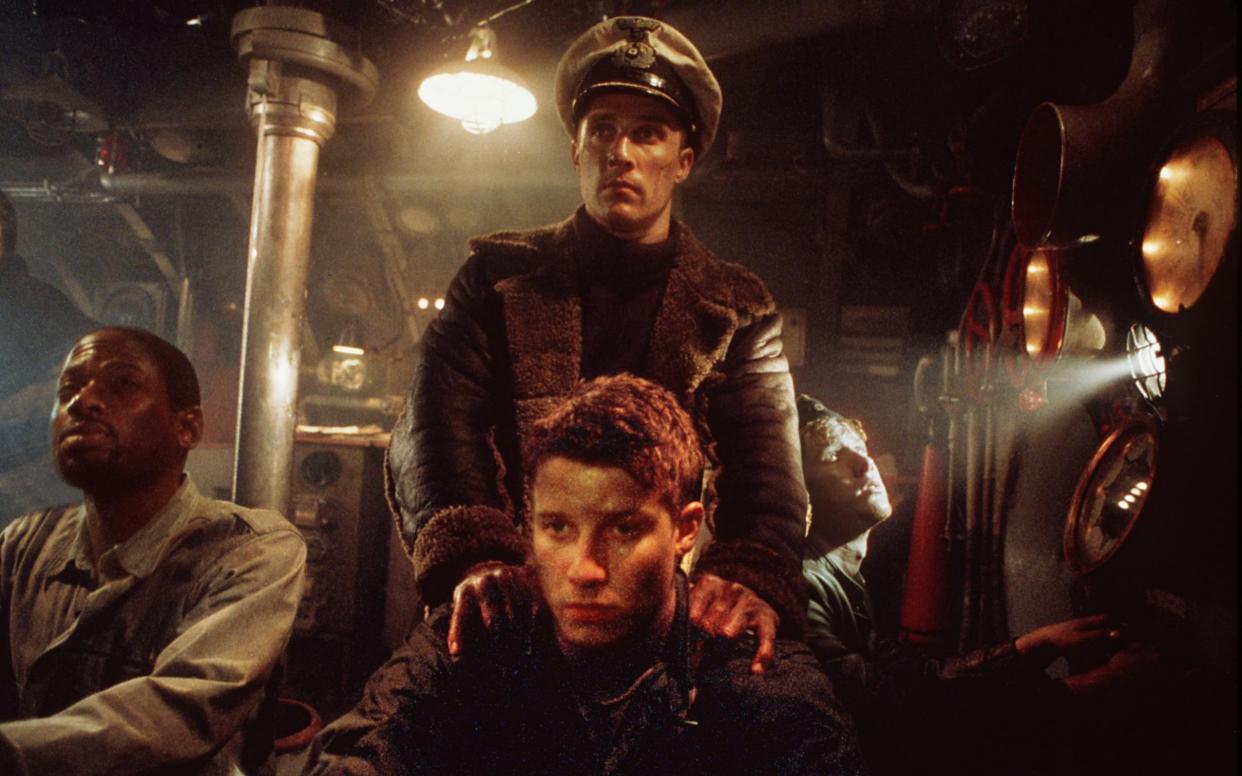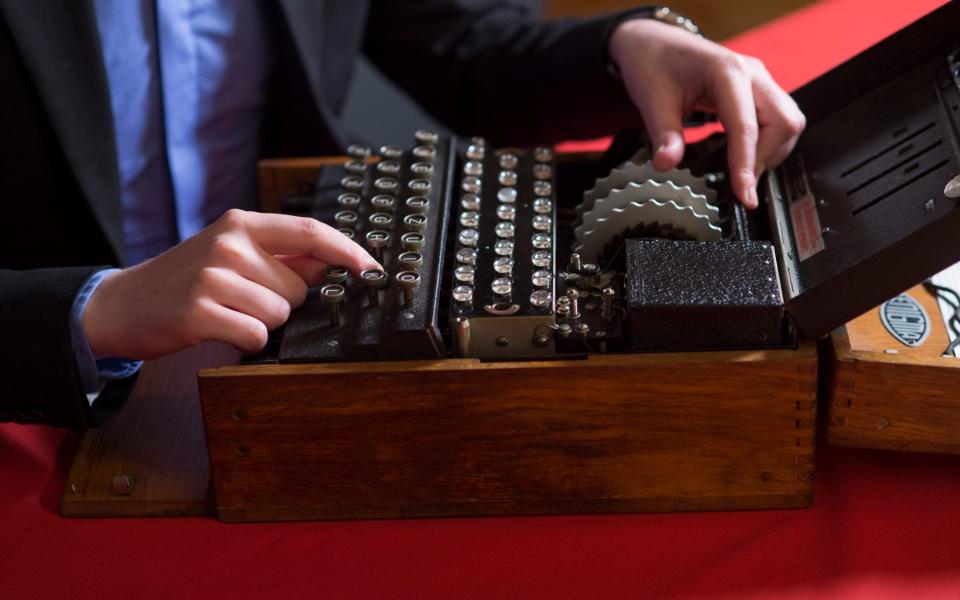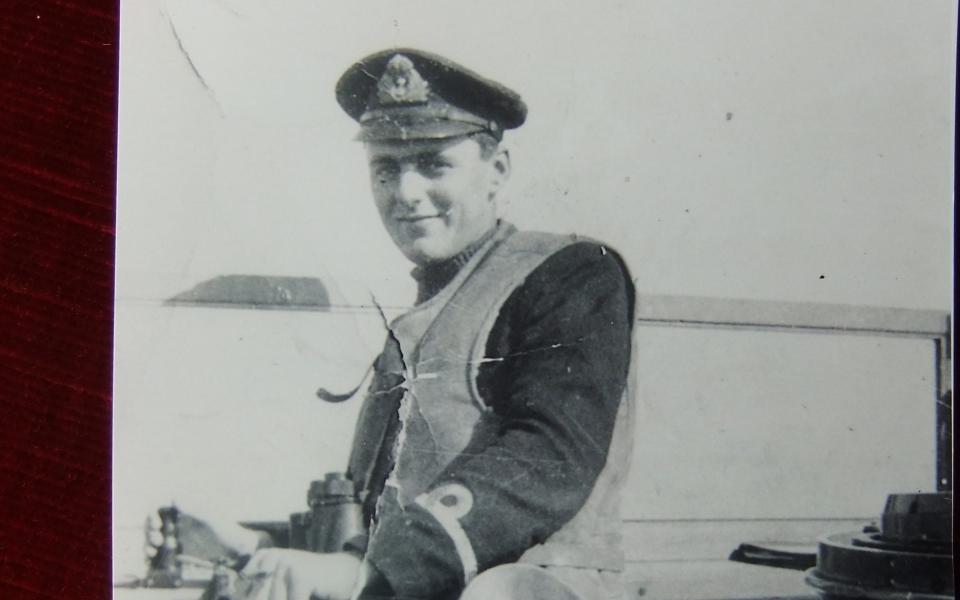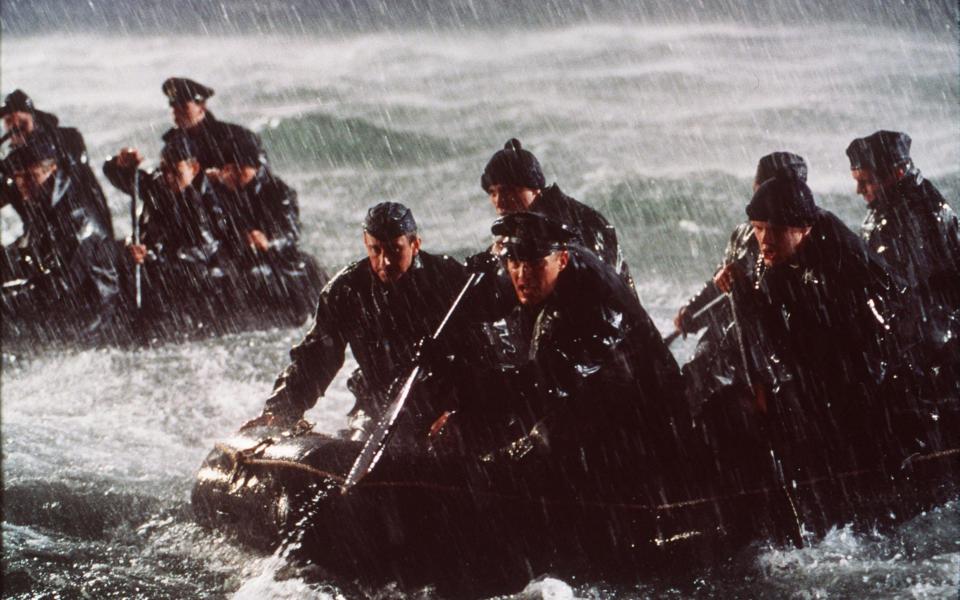‘An affront to the memories of British sailors’: the lies that sank Hollywood’s sub thriller U-571

Anyone who’s seen U-571 knows it was Matthew McConaughey and Jon Bon Jovi who captured the Enigma machine from the Nazis. In a daring mission, the heroes intercepted a damaged U-boat, disguised themselves as Germans, and boarded the sub – kicking off a gun and torpedo fight that saw Jon Bon Jovi die a hero's death, decapitated by a wayward slice of metal (but not, as his earlier work suggested, shot through the heart).
McConaughey would steal the U-boat and its Enigma machine, blow up a Kriegsmarine destroyer, and win the war.
None of that happened, of course. U-571 – directed by Jonathan Mostow and co-written by David Ayer – is a cynical Hollywood fantasy: the kind of crafty historical tinkering which has riled up Brits for years. U-571 is so outrageously fabricated that when it was released back in April 2000, Tony Blair said it was an “affront”.
In truth, it was the British Royal Navy destroyer HMS Bulldog that captured the Enigma machine in May 1941 – seven months before the Americans officially entered the war. The real hero was a 20-year-old sub lieutenant named David Balme, who led a party of eight onto a damaged U-boat – the U-110 – and found the Enigma machine and codebooks.
Dubbed Operation Primrose, it was one of several “pinches” that helped the code-breaker boffins at Bletchley Park crack the naval Enigma. It helped turn the tide in the Battle of the Atlantic and brought forward Operation Overlord – and ultimately the end of the war – several years.
“I still have dreams about it sometimes, you know,” Balme said in 2011, aged 90. “It was the most frightening moment of my life going down that U-boat.”
Invented around the end of the First World War, the Enigma machine scrambled German into cyphertext using a series of rotors. Each rotor displayed different settings. To decipher the code, the receiver of the signals needed to know the rotor settings. Foolishly, the Nazis didn’t believe the code could be broken.
At first, the British could listen to the German’s signals but could not understand them. Bletchley Park – including code breakers Dilly Knox and Alan Turing – cracked the German army and Luftwaffe codes. But the naval codes were crucial in the Battle of the Atlantic, which threatened Britain’s all important supply lines.
As described by Hugh Sebag-Montefiore, author of Enigma: The Battle for the Code, breaking the Enigma was “one of the greatest British coups of the Second World War.”
The first British capture of naval Enigma materials happened on February 12, 1940, when HMS Gleaner discovered and sunk U-33 off the coast of Scotland. Three rotor wheels were discovered. One story – which may be apocryphal – is that the wheels were discovered in the trousers of a captured U-boat sailor. There were other notable pinches, such as the discovery of rotor wheels and codebooks on the German trawler Krebs in March 1941. Two cipher wheels and a document of outdated (but still useful) settings were found.
When U-571 was released in April 2000, it was already under fire for rewriting history. Charles Baker-Creswell, the son of Capt. Joe Baker-Creswell, was criticising the film in 1999, while it was still in production (“This film is not about history, it’s about showbiz,” he said).
Still, U-571 was a hit. It’s lightweight fodder, perhaps, viewed next to the Saving Private Ryan, which was released three years earlier and demanded that war films be punishingly realistic, but still a rollicking ride of explosions and trapped-in-a-submarine tension.
Learning that the U-571 has been damaged by depth charges, the crew of the US submarine S-33 – led by Commander Mike Dahlgren (Bill Paxton) and Lieutenant Andrew Tyler (McConaughey) plan to intercept by retooling their sub to look like a resupply U-boat.

The capture of the U-571 is tense stuff (though Bon Jovi’s head-slicing was later replaced by him being knocked overboard for the sake of getting a PG-13 rating). After the battle, Tyler and the handful of survivors commandeer the U-boat and head for Land’s End with the Enigma.
It doesn’t quite maintain the excitement levels (how exciting can watching some blokes press buttons and spin wheels inside a metal tube get, really?) but the climax is nerve-rattling stuff, as they outsmart a German destroyer to survive. It's more than just their lives at stake. If they’re caught, the Nazis will know the Allies have seized the Enigma machine and change the codes. Thankfully, the Americans save the day.
Really, U-571 is a story about the journey of McConaughey’s character from headstrong officer to responsible commander. At first he’s wincing at the thought of losing his men; by the end he’s using their corpses as bait and sending his shipmates to watery graves. All for the greater good of defeating the Nazi menace on Britain’s behalf.

“Mr Tyler, you ever need a chief,” says shipmate Harvey Keitel, impressed by the lieutenant’s savvy under pressure, “I’d go to sea with you anytime.”
The real question is this: why use the real-life Enigma as the “MacGuffin” to tell Tyler’s story? Hollywood has often tinkered with historical fact – be it for industry or star ego (that means you, Mel Gibson), streamlined narrative, or American box office dollars. But basing U-571 on such a fundamental whopper ensured the film could only be seen within the context of its wanton historical inaccuracy, damaging the rep of what is otherwise a solid nautical romp.
Speaking in 2006, David Ayer called it “a distortion... a mercenary decision to create this parallel history in order to drive the movie for an American audience.” He told Radio 4’s The Film Programme: "Both my grandparents were officers in World War Two, and I would be personally offended if somebody distorted their achievements."
Ayer took a lot of flak for the script. Reflecting on the film again in 2014, Ayer said he was “thrown under the bus” in the U-571 fallout.
“I was one of three writers. It wasn’t my idea,” Ayer said. “I was a 26-year-old kid who came in on a rewrite and was happy to get paid that much for a studio job… it just sucks because I f–––––– love the UK. I love the people over there, I love London and I love working there. The irony is there’s this perception in the UK that somehow I’m anti-British and it couldn’t be further from the truth. It’s heartbreaking.”

It was Jonathan Mostow who wrote the original script (Sam Montgomery is co-credited as the third writer). Mostow wrote it before directing Breakdown, his adrenaline-charged Kurt Russell action-thriller, but put the U-571 script “in a drawer”. He didn’t think anyone would make a movie on water. Hollywood was still recovering from the trauma of Waterworld.
Even the most basic detail of U-571 is fictionalised. The real U-571 wasn’t involved. It was commissioned in May 1941 and was sunk on January 28, 1944 in the North Atlantic off the west of Ireland. Its crew of 52 were all killed.
Indeed, the heroes of HMS Bulldog weren’t the only ones who should have been affronted by U-571. The film’s German U-boat commander, Kapitänleutnant Günther Wassner (Thomas Kretschmann), has his men massacre a lifeboat-full of Allied survivors early in the story. As described by historian and archivist Timothy P. Mulligan, the Germans are depicted as “cruel murderers but inept seamen”.
“Among over 2,400 recorded sinkings by German U-boats in World War II, only one known incident involved the killing of survivors,” wrote Mulligan in a review of the film. “And U-boat Commander-in-Chief Admiral Karl Dönitz directly opposed Hitler's proposal in September 1942 to adopt such a policy.”
(Interestingly, the commander of U110 was Fritz-Julius Lemp. Two years earlier, he was responsible for torpedoing the SS Athenia, which killed 117 civilian passengers and crew, just hours after the declaration of war. He claimed it was a mistake but was almost court martialed.)
The real Operation Primrose took place on May 9, 1941. Deep into the six year-long Battle of the Atlantic, the U-110 was stalking the trans-Atlantic convoy OB318 – 35 merchant ships arranged into nine columns – as it travelled west. U-110 torpedoed two of the merchant ships, but was caught in a formation trap set by Capt. Baker-Cresswell.
As described in Sebag-Montefiore's account, the HMS Aubretia, hidden away on the convoy’s starboard, charged in and pummeled U-110 with depth charges, damaging the U-boat and forcing it to the surface.
As the Germans poured out, Baker-Creswell mistakenly believed they would shoot from the U-boat deck gun so he ordered his crew to fire on them. There was panic: some Germans leapt into the water and drowned; one had his eye shot out; another had his head burst open by a shell. Lemp thought the U-110 would sink and take the Enigma with it. When he saw it wasn’t sinking, he tried to swim back. He was never seen again.
Realising the German sailors were in fact surrendering, HMS Bulldog ceased firing. Baker-Creswell ordered Balme over to U-110 to “get whatever you can out of her – documents, books, charts, and get the wireless settings, anything like that.” Balme didn’t know what awaited him inside – scuttle charges, Nazi sailors ready to ambush – but had to holster his pistol to climb down into the belly of the U-boat.
"Going down those ladders and thinking there may be Germans ready to shoot you ... it was terrifying," Balme told the BBC back in 2000. “We couldn't believe that they would have just abandoned this submarine. It was something that haunted me for 15 or 20 years afterwards."
The submarine was empty and spotlessly tidy. The party found the Enigma machine screwed down in the office, which telegraphist Alan Long described to Balme as “a funny sort of instrument, Sir, it looks like a typewriter but when you press the keys something else comes up on it.”
The HMS Bulldog went to investigate a U-boat sighting and left Balme and his crew behind. They were on the U-110 for six hours. As detailed by Sebag-Montefiore, when the Bulldog returned, Baker-Cresswell sent sandwiches to the U-110 – a scene that feels delightfully quaint in its Englishness. Baker-Cresswell attempted to tow the U-110 to Iceland but it sank en route.

Timothy P. Mulligan gave credit to U-571 for its design of the Enigma machine, documents, and interiors of the submarines. “Regrettably these qualities exhaust director Jonathan Mostow's best efforts at historical verisimilitude,” he wrote.
Mulligan lists other inaccuracies: how easily the S-33 finds the U-571 in a storm (“A remarkable feat in the pre-GPS era”); the US submarine duping the U-boat via lamp signals, without knowing the German recognition signals; a single engine reconnaissance plane in the middle of the ocean ("presumably fueled by air and water"); a gun fight in the cramped U-boat interior; torpedoes that inflict giant Hollywood explosions; and the idea that just a handful of US sailors could run a U-boat with no training (“submarine crews averaged 45-50 men for a Type VIIC U-boat for a reason”).
Arguably, one historical inaccuracy is how much importance is put on the incident. The message in U-571 is clear: it’s the event that won the war. King George VI said that Operation Primrose may have been "the most important single event in the whole war at sea”. But Hugh Sebag-Montefiore argues that “no single capture of material enabled the codebreakers to break the Naval Enigma once and for all.”
He points to other events, such as the capture of documents from the German weather ship München two days earlier, which included naval Enigma settings for June.
In February 1942 the Germans added a fourth rotor to the Enigma machine, beginning a 10-month blackout during which time the codes couldn’t be read. Hundreds of thousands of tons of allied shipping was lost each month.
In October 1942, crewmembers from the HMS Petard boarded the U-559 and captured more Enigma materials. Sebag-Montefiore called it “by far the most dramatic of all the Enigma codebook captures from U-boats.” The US Navy did capture Enigma materials from U-505 on June 4, 1944.
After the release of U-571, Labour MP Brian Jenkins raised the film during Prime Minister’s Questions. He said U-571 was an "affront to the memories of the British sailors who lost their lives on this action".
Tony Blair responded: "I agree entirely with what you say... we hope that people realise these are people that, in many cases sacrificed their lives in order that this country remained free."
The people of Horsforth in Leeds, where locals had raised £241,000 for the HMS HMS Aubretia, were upset. Paul Trusswell, the MP for Pudsey, felt strongly enough to write a letter to Bill Clinton in protest of the film. The BBC reported that Trusswell received a reply: “The President acknowledged the role played by the people of Horsforth and tried to assure them that the movie was a work of fiction.”

Lieutenant David Balme, who was 80 by the time the film was released, was less offended. "I was a bit surprised and initially I thought it was a pity,” he told the BBC. “But I don't know why anyone complains because no-one had heard of this before the Americans made the film. Once I got working with them I realised that the scale they were going for was beyond the budget of a British film."
Balme, who died in 2016, consulted on the film and spent two weeks on location, off the coast of Malta (“Matthew McConaughey is a terribly nice chap,” he said). Balme tried to persuade Jonathan Mostow to include a line at the start explaining that U-571 was fiction. He had to settle for a dedication at the end of the film instead.
“This film is dedicated to the bravery of Allied sailors and officers who risked their lives capturing Enigma materials from U-boats during the Battle of the Atlantic,” it read, with a special nod to HMS Bulldog and HMS Aubretia. The dedication is disappointingly absent on the Amazon Prime version of the film.
Hugh Sebag-Montefiore wrote that the criticism of U-571 undermines the Americans's all-important role: they manufactured the machines that regularly broke the Enigma, which British engineers had been unable to produce with any reliability.
The film did at least highlight the incredible pinch of HMS Bulldog, albeit through controversy and Hollywood self-importance. David Balme, for one, could only see the positives: "It brings home the whole Battle of the Atlantic to a generation who otherwise would have known nothing about it," he said.

 Yahoo News
Yahoo News 
